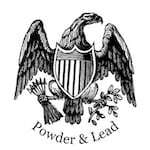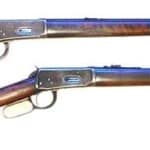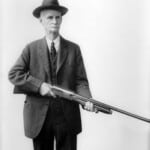
Origins and Invention of the Winchester Model 1890 and Model 90 Rifles
The Winchester Model 1890 and its successor, the Model 90, remain two of the most iconic pump-action .22 rifles ever produced. Designed by the legendary John Moses Browning, these rifles set the standard for small-caliber repeaters, offering accuracy, reliability, and durability that kept them in production for over half a century. Their widespread use in hunting, target shooting, and even carnival shooting galleries cemented their reputation as some of the finest rimfire rifles ever built.
This article explores the origins, design, production history, competitive landscape, and lasting legacy of the Winchester Model 1890 and Model 90. We also examine their technical specifications, caliber offerings, and collector value, ensuring a complete resource for enthusiasts, historians, and collectors alike.
Winchester Repeating Arms and the Birth of the Model 1890
Founded in 1866 by Oliver Winchester, the Winchester Repeating Arms Company became one of the most influential firearm manufacturers in American history. By the late 19th century, the company had firmly established itself as a leader in lever-action rifles, thanks in large part to the brilliant designs of John Moses Browning.
Under the leadership of Thomas Gray Bennett, Winchester sought to expand into the growing market for small-caliber, repeating rifles. While single-shot .22 rifles were common at the time, pump-action designs were relatively new. Winchester recognized the opportunity to introduce a reliable, fast-firing .22 rifle suitable for target shooting, small-game hunting, and general utility use.
Browning, already known for his lever-action designs, developed a pump-action repeating rifle specifically for rimfire cartridges. Winchester quickly acquired the patent, refining the design into what would become the Model 1890.
Design and Innovations of the Model 1890
The Winchester Model 1890 introduced several key innovations that set it apart from competing designs:
- Solid Frame Construction: Unlike later pump-action rifles with takedown designs, the earliest Model 1890s featured a solid one-piece frame, improving accuracy and durability.
- Caliber-Specific Barrels: Each Model 1890 was chambered for a specific .22 rimfire cartridge (.22 Short, .22 Long, .22 Long Rifle, or .22 WRF). Unlike later designs, they could not interchangeably fire different .22 rounds.
- Pump-Action Mechanism: The tubular magazine and slide action provided rapid follow-up shots, making it one of the fastest-cycling small-caliber rifles of its time.
- Octagonal and Round Barrels: Early models were primarily offered with octagonal barrels, while later versions could be found with round barrels, particularly in the Model 90 variation.
- Improved Ergonomics: The straight-grip stock, crescent-shaped steel buttplate, and checkered forearm provided excellent handling characteristics.
Production History and Variations
First Model (1890-1892)
- Solid frame construction (non-takedown)
- Chambered only in .22 Short at first, though some later examples were offered in other .22 calibers.
- Octagonal barrels were standard.
- Serial numbers: 1 – approximately 15,500
Second Model (1892-1908)
- Introduced the takedown feature, allowing easier cleaning and transport.
- Available in .22 Short, .22 Long, and .22 Long Rifle.
- Production expanded significantly, making this one of the most common versions.
- Serial numbers: 15,500 – approximately 325,000
Third Model (1908-1941) – Winchester Model 90
- Further refinements to mechanics and materials.
- First to be chambered in .22 WRF, a more powerful rimfire round exclusive to Winchester rifles.
- Available in all four standard .22 calibers.
- Distinguished by minor design updates and slight action improvements.
- Serial numbers: 325,000 – approximately 1.6 million (including both Model 1890 and Model 90 production)
Factory Production and Manufacturing Details
The Winchester Model 1890 was manufactured at Winchester’s New Haven, Connecticut factory, which was one of the largest and most advanced firearm production facilities of its time. The factory's efficient machining processes and high-quality steel alloys contributed to the rifle's legendary reliability and accuracy.
Production Numbers:
- Model 1890: Approximately 849,000 units produced (1890-1932)
- Model 90: Approximately 736,000 units produced (rebranded from the Model 1890, continued until 1941)
- Total combined production: Over 1.5 million rifles, making it one of the most successful pump-action rifles in history.
Comparison to Competitors
During the late 19th and early 20th centuries, Winchester faced competition from Marlin, Remington, and Savage, each offering their own pump-action rifles:
| Manufacturer | Model | Year Introduced | Notable Features |
|---|---|---|---|
| Marlin Firearms | Model 1892 | 1892 | Similar action, but less successful than the Model 1890 |
| Marlin Firearms | Model 20 | 1907 | Direct competitor, but lacked Winchester’s market penetration |
| Remington Arms | Model 12 | 1909 | Concealed hammer design, smoother action |
| Savage Arms | Model 1903 | 1903 | Unique magazine-fed system, but never matched Winchester in sales |
Despite stiff competition, Winchester dominated the market, thanks to its reputation for quality, extensive distribution network, and the widespread use of the Model 1890 in shooting galleries and hunting circles.
Replacement Models and Evolution
By the early 20th century, firearm technology had evolved, and Winchester sought to modernize its pump-action rifle lineup. The following models replaced the Model 1890/90:
Winchester Model 1906
- A more affordable version of the Model 1890, designed for younger shooters.
- Chambered for .22 Short, .22 Long, and .22 LR interchangeably.
Winchester Model 61 (1932)
- Introduced a sleeker design with an internal hammer.
- Capable of firing multiple .22 rimfire rounds, unlike the caliber-specific Model 1890.
Winchester Model 62 (1932)
- Direct replacement for the Model 1890/90, featuring a simplified takedown mechanism.
- Remained in production until 1958.
Legacy and Collector Value
The Winchester Model 1890 and Model 90 remain highly collectible today, with certain variations commanding premium prices among firearms enthusiasts. Collectors value:
- First Model solid-frame rifles (especially in original condition)
- High-grade models with factory checkered stocks
- Rare calibers like .22 WRF
- Special-order configurations (e.g., longer barrels, engraving, deluxe wood finishes)
Today, these rifles are regarded as pinnacles of American craftsmanship, with many still functioning flawlessly over a century after their production.
Conclusion: A Lasting Mark on Firearms History
The Winchester Model 1890 and Model 90 were far more than just firearms—they were symbols of American ingenuity and superior firearm design. Created from the brilliant mind of John Moses Browning and backed by Winchester’s world-class manufacturing, these rifles became the benchmark for pump-action .22 repeaters.
Their popularity in shooting galleries, hunting fields, and collectors' circles ensures their legacy will endure for generations. With over 1.5 million units produced, the Model 1890 and Model 90 remain cornerstones of Winchester’s storied history, solidifying their place as some of the greatest rimfire rifles ever made.
Join the discussions about these rifles at the Winchester Collectors Association's forum.
If you know of any forums or sites that should be referenced on this listing, please let us know here.




